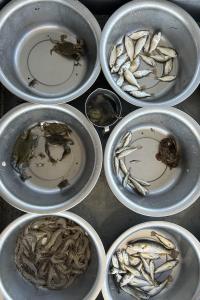Indices of Abundance
What is an index of abundance?
An index of abundance is a relative measure of the size of a population or sub-unit of the population, such as a year class. It is usually measured as number (or weight) of fish caught per standard unit of fishing effort.
How are the Survey's indices calculated?
First, spatial and temporal components are selected. The spatial component is determined by the range of the animal and catch rates across the sampling area. Depending on the species, the sampling area can include river segments and/or Bay segments.
Most species targeted are available for a limited amount of time during the year because of seasonal migrations in and out of Chesapeake Bay. The temporal component of the index is a 3-, 4-, or 6-month window when the species is most fully recruited to the estuary and the sampling gear.
With both the spatial and temporal components selected, the data are statistically treated to produce a weighted geometric mean catch per trawl, or more simply put, an average catch rate. These values can only be compared to data treated in the same manner. With several years of data, the results can provide a very informative picture of a species' spawning and year-class success in Chesapeake Bay.
For most target species, individuals become susceptible to, or can be caught by, the survey nets several months after hatching, when they are referred to as Age 0 (young-of-the-year) or juvenile fish. Some species are also (or exclusively) caught as older individuals, and indices are also calculated for these groups. Catches of older fish can consist of one year class or several year classes. Where these indices clearly represent only one year class, they are labeled as "Age 1"; where they include several year classes, they are referred to as "Age 1+".
Selected Indices of abundance:
| American Eel | Channel Catfish | Striped Bass |
| Atlantic Croaker | Scup | Weakfish |
| Bay Anchovy | Silver Perch | White Catfish |
| Black Seabass | Spot | White Perch |
| Blue Catfish | Summer Flounder |
The graphs and tables in this section show survey results for 1988-2022. In June 2015, the Survey transitioned to a new vessel (R/V Tidewater) and a new net. Data collected after the transition have been adjusted by a species-specific calibration factor. Tables are available as links to downloadable Microsoft Excel Files.
The Random Stratified Index is presented for most species and represents the weighted geometric mean catch per tow (RSIGM). This index results from calculating stratum-specific means and variances and combining the stratum-specific estimates using weights based on stratum area.
A delta lognormal model (RSIDelta) is used to calculate indices for Blue Catfish, Atlantic Croaker, and American Eel. This method calculates stratum-specific means on log-transformed positive values only and adjusts the stratum means by the proportion of positive tows. The stratified mean is then calculated in the usual manner.
The methods used to calculate indices of abundance from the VIMS Juvenile Finfish data sets are constantly under review. The cut-off lengths used to separate young-of-year (YOY) from older fish, along with the geographic and temporal data limits used for each species, may change as more research is done.
